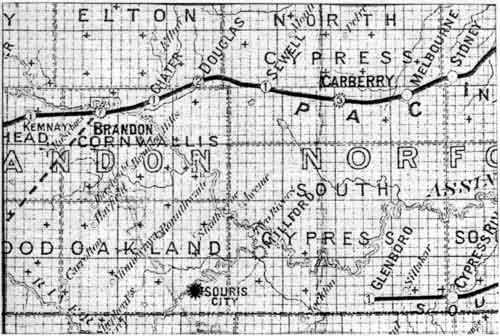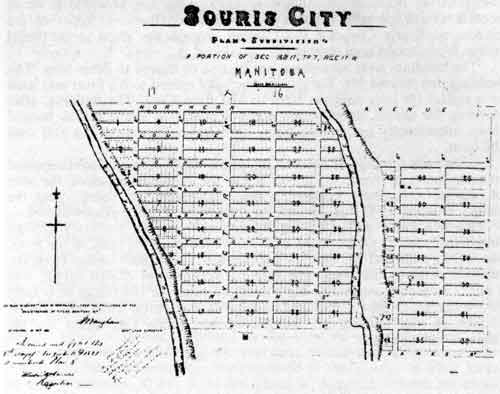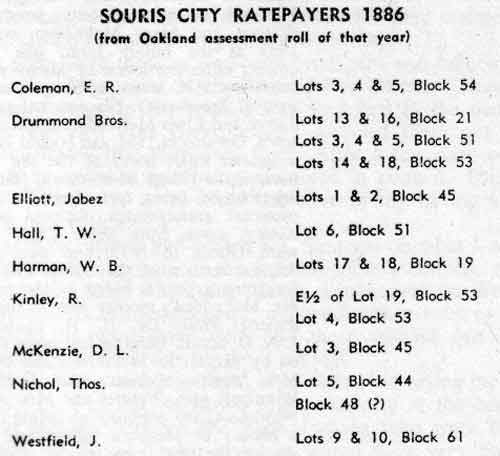Manitoba Pageant, Winter 1972, Volume 17, Number 3
|
The following article is based on the reflections of Mr. McFadden’s mother and on supplementary material from Dr. H. H. Saunderson and J. A. D. Stuart. Biographical notes were provided by Mr. McFadden and his sister, Mrs. Jemima Webster, 1028 Garfield Street, Winnipeg. Mrs. Webster and Mrs. A. J. Elliott, Wawanesa, are presently [1972] gathering material for a history of Methven village and would appreciate hearing from anyone who may have old documents, letters, or diaries referring to the early days of settlement in the village and surrounding country.
The village of Souris City was situated on the north bank of the Souris River about two miles southwest of where Wawanesa is now located.
In 1879 a party of land seekers took up “squatters’ rights” on land near where the village was eventually built. My grandfather, Richard Kinley, who had journeyed west from Prince Edward Island, was among this party. He had acquired some knowledge of surveying whilst working with his father and, as the township lines had already been run, he was able to find the approximate location of his land.
The first summer they built a cabin, mostly of sod, as logs were hard to come by, and they put up some hay. Mr. Richard Cory and his two sons, Dick and Gus, and Mr. Orlin Elliott, stayed with them that winter. The next spring a cavalcade of fourteen wagons and oxcarts carried the wives and children of the original party, as well as friends and relatives. They struck southwest from Portage la Prairie and arrived at the Elliott Settlement, as it was then known, on 6 June 1880.
They lived in tents until better accommodation could be built. Lumber had to be hauled from the junction of the Souris and Assiniboine rivers. It was brought up the Assiniboine on flat-bottomed boats along with other supplies.
Among the earlier settlers was a Mr. William Scott, an enterprising contractor from Toronto, and his son, William James. He immediately thought of the possibility of establishing a town. He selected a picturesque spot where the river made one of its many horseshoe loops, which might also be a good place for a railway bridge. Anyone thinking of locating a town along the river had that possibility in mind. In all, Mr. Scott and his son purchased three sections and one-quarter of land from the Canadian Pacific Railway and the Crown.
Mr. Scott arranged for a survey to be made on the west half of section 16-7-17, which was divided by the river, and the east half of 17-7-17. A plan was made by Mr. W. J. Vaughan and registered on 14 November 1881. Mr. Scott then returned to Toronto where he formed The Toronto, Manitoba and North West Land Company, which was incorporated by a Dominion Charter in 1882.
It was not long after the property was put on the market until building operations commenced.
At one time the village of Souris City had three stores, a boarding house which grandmother ran with the help of my mother and her two sisters. The Scotts erected a two-storey residence. This also housed the post office. A schoolhouse served as a church but there was a separate parsonage. A small grist mill, powered by steam, did the gristing for the settlers in the immediate area. A larger mill, which was planned to be operated by water power, never materialized. A small blacksmith outfit was brought from the east by Mr. Thomas Elliott, who realized that with all the breaking to be done, there would be plenty of shears to be sharpened. Grandfather was the blacksmith, first on his own farm and then in the village. There were also a number of private dwellings in the village. A brick kiln was one of the first industries, the bricks being used chiefly for wells rather than houses.
The need for a bridge to accommodate settlers from the south was recognized, and a temporary bridge, which had to be taken up in the winter, was built. What was thought to be a permanent structure was built later, but it lasted only twenty minutes when the ice went out in the spring. A ferry was then put into service, which operated back and forth in response to the river’s current. A small toll was charged for each crossing. The river was much wider and deeper than it is today.
The first death recorded in Souris City was a Mr. Aborn, who was accidentally drowned while bathing in the river. Grandfather, a man of many talents, was asked to make and trim the coffin. Mr. Aborn is buried in a cemetery about a mile southwest of where the village was located. This cemetery can still be found although it is hidden by brush and trees. There are a number of graves there, both adult and children, one being grandfather’s aged mother. A small stone marks the grave of a pioneer, Mr. Stewart Robertson. Some of the graves contain the victims of a typhoid epidemic which swept through the district in 1887.
Life, I suppose, was much the same as in most other rural districts at that time. The nearest railroad town was Brandon, twenty-five miles to the northwest. The CPR had an agreement with Sir John A. Macdonald’s government that for a period of twenty-five years there were to be no branch lines built in a northwesterly direction connecting with the main line of the CPR. This was a thorn in the flesh of all the settlers. In 1887 my grandfather, James McFadden, had 18,000 bushels of wheat that had to be hauled all the way to Brandon by horses and wagons. Some farmers were even worse off, living as far as forty miles from the nearest railway.

The monopoly was eventually broken. The Liberals headed by Premier Greenway were able to get the monopoly clause withdrawn. As a result the Morris branch of the Northern Pacific and Manitoba Railway was completed to Brandon by 1 August 1889. This line provided a much needed service for local farmers, but it shattered the civic hopes of the citizens of Souris City, for the railroad crossed the river at the point where Wawanesa is now located.


In 1887 the County of Brandon and Brandon Municipality covered 1,296 square miles. Two years later the territory was divided into six municipalities - Daly, Elton, Whitehead, Cornwallis, Glenwood, and Oakland. Souris City was in Oakland Municipality.
The buildings were torn down one by one or moved to other sites. The building that housed Mr. Harrison’s store was moved to his farm and used as a stable. He later sold the farm to Mr. Fred Cory. The building, after standing for nearly ninety years, got into such bad shape it was burned down intentionally by his daughters, who live in Wawanesa but still own the farm.
Thus ends the saga of Souris City, a tale which was no doubt repeated in many parts of Western Canada where the railroads bypassed the sites of original settlements. Millford, a few miles down the Souris, went the same way when the CPR crossed the river where Treesbank now stands.
When I was a young lad my mother used to take me berry picking to what we called “Old Souris City.” As we followed the bank of the river, she would point out the sites of the different stores and houses from the mounds of earth that were still there. I have always chided myself that I didn’t have the foresight to dig among the ruins for old pieces of pottery and other relics that I could have kept as mementos. Now the land is broken up and all you can see where once Souris City stood are the fields of waving grain.
Page revised: 19 February 2015